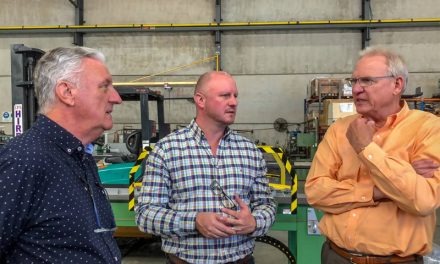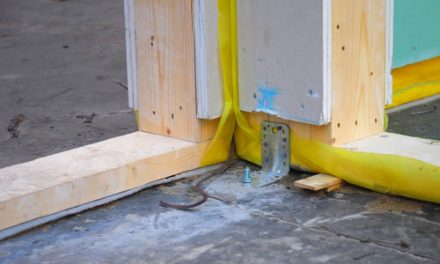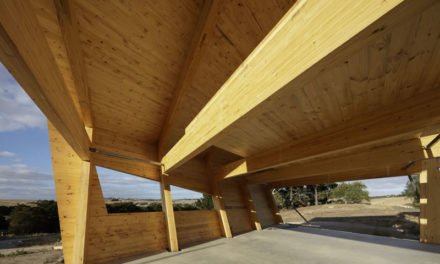How to frame the benefits of using timber in the built environment for your customers. By Kersten Gentle, CEO of FTMA.
We all have a role to play in advocating for the environmental benefits of timber. Your voice is important, but often I get told that people are nervous about responding to questions from customers, as they don’t necessarily know the facts.
FTMA has collated the most common questions and written a simple script, below, to show you how easy it is to promote the environmental benefits of timber.
The built environment is currently responsible for nearly 40% of the world’s carbon emissions. By implementing policies that target the use of renewable materials, such as timber, which stores carbon for life, we can build a greener future.
TIMBER: THE ANSWERS
Q. Why should we use wood and how does timber store carbon for life
Trees absorb carbon dioxide (CO2) from the atmosphere as they grow. Using the process of photosynthesis and the solar energy from the sun, the CO2 is converted into emitted oxygen, which we breathe, while the carbon is stored in the woody mass of the tree. When the tree is harvested for timber products, that carbon is stored and locked in the timber for the life of the product while it is being used or if it is recycled into another product. The accumulated storage in Australia’s harvested wood products in-use is estimated to be approximately 97 million tonnes of carbon.
Prof Ian Chubb, the former Australian chief scientist, told journalists in January that: “The only pathway known to science that has the immediate capacity to remove greenhouse gases, particularly CO2, from the atmosphere at scale is photosynthesis, the means by which plants absorb CO2 and water to create energy to fuel their eventually growth.”
Timber products remove more CO2 from the atmosphere than they emit through the manufacturing process, unlike other materials. In fact, 1m3 of softwood contains roughly 0.9 t (tonnes) of CO2, and 1m3 of hardwood has 1.2 t of CO2.
Q. How much carbon is stored in the average timber framed house?
An average Australian home uses approximately 12m3 of sawn softwood timber framing, which effectively stores almost 3 t of Carbon – and which equates to approx. 7.6 t of CO2. Over 7 t of oxygen is also released by those trees, replenishing the atmosphere during the photosynthesis process.
Q, How quickly can you grow that wood back in Australia’s forests?
Australia’s sustainable and renewable forest industry replants each tree harvested, which in turn continues the natural carbon cycle (over 70 million trees each year).
Australia’s softwood plantations can regrow the timber used in an average framed house in just 150 seconds! Timber grows back, steel and concrete don’t.
Q. What can we do with timber products at the end of their life?
Timber has the ability to be a fully circular-economy positive material that at the end of its first life can be reused, recycled or have its energy recovered as bioenergy.
At end-of-product use, timber products should no longer seen just as ‘waste’, but effectively they should be seen as becoming a valued feedstock for another process; either a by-product (recycling), or recovered resource for another industrial process or as regenerative resources for nature (e.g. compost or, for biomass-based products, energy generation – displacing non-renewable fossil fuels).
The City of Amsterdam has a roadmap to become one of the first fully circular cities. As a key part of this goal, it has introduced the Green Deal Timber Construction policy, which mandates that all new construction must include at least 20% timber or other biobased materials from 2025. The city estimates this will immediately reduce 220,000 t per annum of CO2.
Q. If timber is placed in landfill, does it decay and emit carbon?
At the end of the service life, if it can’t be reused or recycled any further, some wood products may be disposed of in landfill and under the anerobic conditions of most landfills this carbon will remain stored. Recent research has shown that the rate of decay in landfill is much slower than previously thought, with studies finding that more than 95% of the carbon in wood remains stored after being buried for 30 years in landfill. In theory, if there is no oxygen in the landfill, virtually no carbon loss will occur, and the carbon will remain stored forever. This fact is at odds with many current policies that make the demonstrably incorrect assumption that ‘all the carbon is released as soon as the wood product is disposed of in a landfill’.
Q. What about Green Steel? Is that an answer to net-zero housing?
The concept of ‘Green Steel’ – manufactured without the use of fossil fuels – is still just that, a concept. While it’s an admirable goal, the reality is that green steel currently is not available to the market, outside a very few experimental programs.
The steel manufacturing sector’s aim is to transition from coal-fired plants to electric and water plants which will allow hydrogen production. However, hydrogen production at scale will require billions of dollars of investment in renewable power generation and is also not a current solution.
Europe’s biggest steel maker, ArcelorMittal, has told the Financial Times that decarbonising its operations on the continent in line with EU targets could cost them up to $40 billion; as yet the technology is still not available within any market.
Additionally, no matter what changes are made to steel’s manufacturing process, you cannot replace the ore, rocks and minerals extracted from the planet for steel or concrete. However, by using certified, renewable and sustainable plantation timber, you can be guaranteed the trees used in a house frame are replanted and regrown and the cycle of carbon storage continues.
Q. Does Australia have enough timber to meet our demands?
Australia needs to put more trees in the ground if we are to be self-sufficient when it comes to our timber needs.
Currently we import approximately 22% of all our structural timber needs, and it is envisaged that within the next decade this could rise to 40%. Australia is fortunate to have quality importers, who are committed to the Australian market.
The Federal Government has made policy changes which will allow greater investments into plantations, such as the removal of water rules and inclusion of plantations with the Emissions Reduction Fund. Several state governments are also funding plantations.
Q. What evidence is there to show that timber stores carbon for life and that we should be using more timber to tackle our climate crisis?
Recently, the Intergovernmental Panel on Climate Change (IPCC) cited sustainable forest management along with sustainably produced forest products, as key solutions to fighting climate change.
When you look at countries leading the way in climate action, one thing they have in common is sustainable construction policies that recognise the role renewables, such as timber, play in lowering the built environment’s carbon emissions.
For example, France has introduced a policy that all new public buildings must be built with at least 50% wood or other natural materials. This policy not only aligns with the country’s net-zero targets, but also with their ambitions to host the most sustainable Olympics ever in 2024. The Olympic Village will include beautiful mid-rise timber buildings, which will be turned into social housing after the games, and which will store carbon for life.
The Swedish city Växjö, dubbed the ‘Greenest City in Europe’ is aiming to be fossil fuel free by 2030. Växjö’s declaration of becoming fossil fuel free states: “Växjö builds in wood. We build passive houses, low-energy houses and energy plus houses in close collaboration between the municipality, private sector and academia.”
Currently, over 50% of all new builds are built with timber, a target that was set by the city and reached in 2020.
Furthermore, the Swedish municipality’s steering document for sustainable development explains that Växjö needs to build sustainably and continue to be a role model for wood construction.
The Wood Building Programme coordinated by the Finnish Ministry of the Environment, has set out national targets for the use of wood in public construction. These targets were set as the Finnish Government identified timber construction as a key measure for reducing regional emissions, as timber stores carbon dioxide in the building stock. Targets have been set for the share of timber in all new public construction and for the types of buildings with the greatest construction volumes, including a goal of 65% of timber construction of educational buildings by 2025.
The City of Amsterdam’s Green Deal Timber Construction mandates that 20% of all new construction in the Dutch capital must be constructed with wood or other biobased materials from 2025. This is in line with the city’s goal to have a fully circular economy by 2050. To qualify as a ‘timber building’, a detached house would have to be constructed with at least 80% timber or biobased materials. For multistorey housing up to 10 storeys, this is reduced to 65%, while multistorey housing over 10 storeys must contain at least 50%.
According to the Amsterdam Institute of Advanced Metropolitan Solutions (AMS Institute) this move will lead to an annual reduction of approximately 220,000 t of CO2 emissions (equivalent to the average emissions of 22,000 households).
Q. Will these kinds of policies be introduced in Australia?
If Australia is fair dinkum about tackling our climate crisis, then we must act now. This isn’t about reinventing the wheel, but about following in the footsteps of those countries leading the world when it comes to tackling our climate crisis.
We must introduce policies that make a difference now. For example, if the Federal Government ensured all social houses built under the National Housing Accord were to be built using timber frames and trusses, they would store nearly 8 million t of carbon.
The National Housing Accord suggests 1,023,866 social houses are built throughout the country. If you calculate these houses by the average 12m3 of framing timbers used in a similar-sized home– storing 7.65 t of CO2 per house – this equates to 7,832,574.90 t of CO2 stored.
How can any government walk away from this benefit?
Q. Will these kinds of policies be challenged by more carbon intensive sectors?
When the City of Helsinki introduced planning and zoning requirements that mandated all building of newly developed neighbourhoods to have timber frames, trusses and façades, it was challenged in their Supreme Court. However, the decision was upheld, as the Finnish Supreme Court recognised the decision did not conflict with EU trade laws, thanks to the sustainable nature of timber as an answer to our climate crisis.
Q. What will happen if sustainable construction policies are not introduced now?
Embodied carbon emissions (see this story for an explanation of what they are) are expected to double by 2050 if Australia doesn’t act now. This is why we cannot wait, and why sustainable construction policies, recognising the pivotal role that timber plays, are needed now.
So come on, learn this script and repeat it to your customers. We have an amazing story to tell that timber stores carbon for life and creates a greener future.
Image credit: Shutterstock












